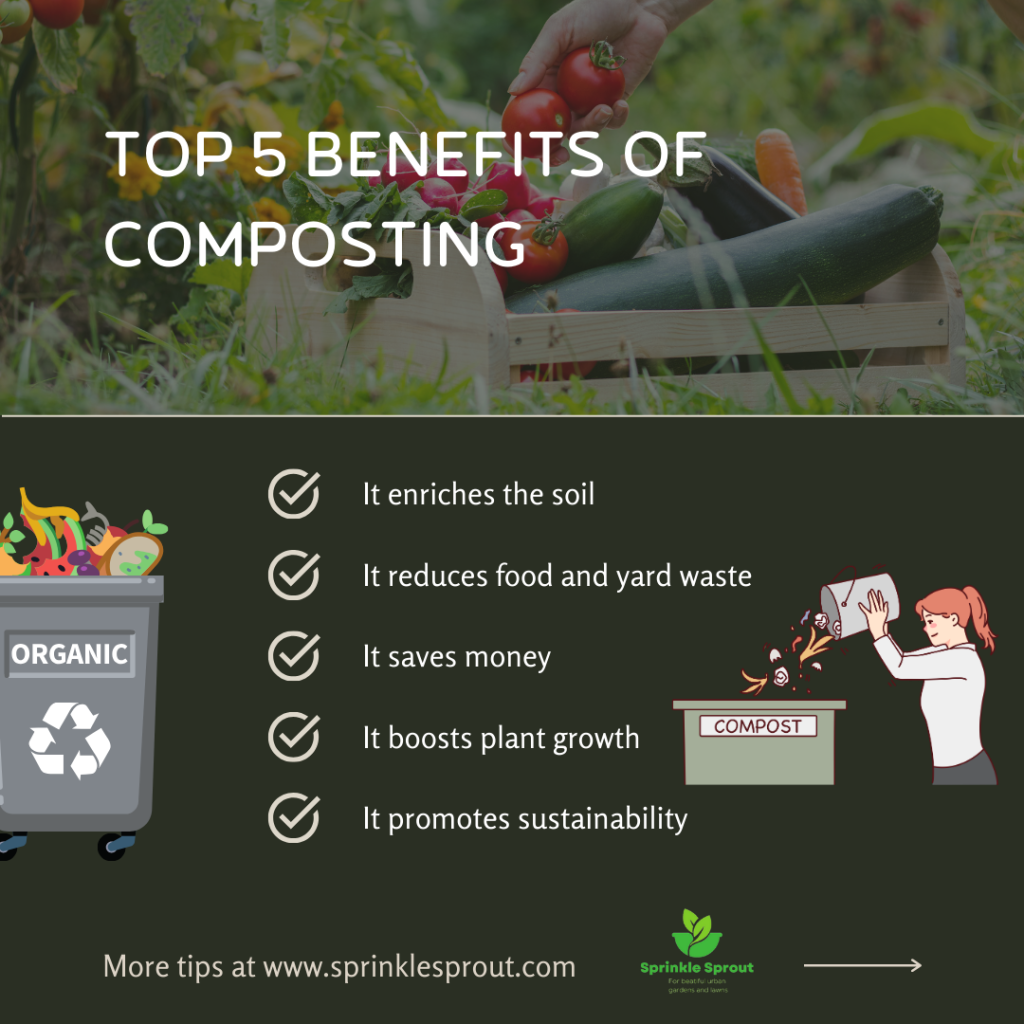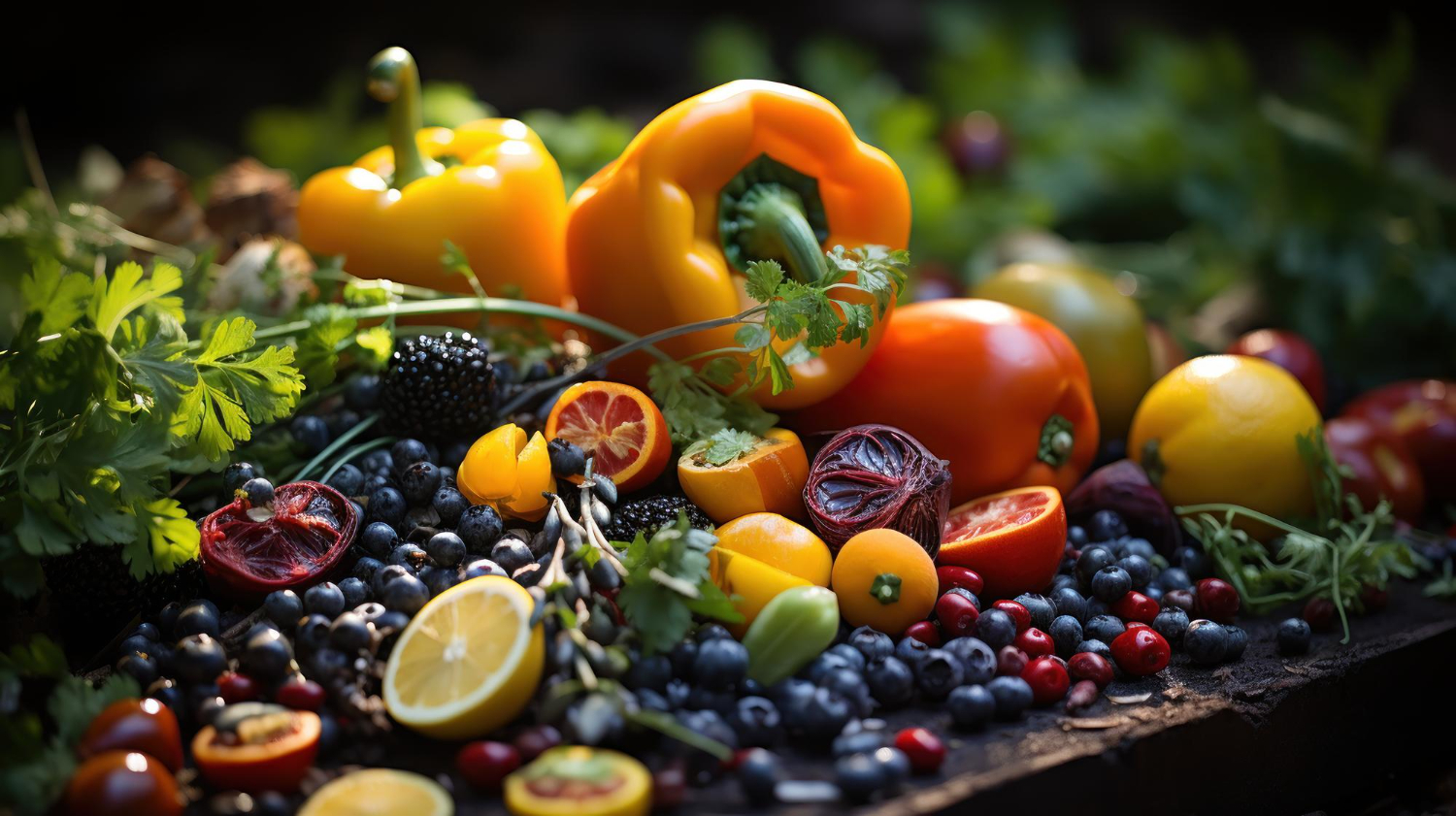Discover how to make your own compost and turn kitchen leftovers into food for your garden!
Did you know your kitchen is a hidden treasure trove for your garden? That’s right, those everyday scraps from your meals aren’t just trash. They’re potential gold for your greenery. Instead of tossing them out, you can turn them into compost for your plants.
Composting is like a magic potion for your garden’s health. It’s also simple and doesn’t cost a penny. Let’s explore how your leftover vegetable peels and coffee grounds can become the feast for your greenery!
What is compost?
Compost is the result of organic materials degrading naturally. It consists of green waste (vegetable scraps, fruit peels, and grass clippings) and brown waste (dry leaves, straw, and paper). Bacteria, fungi, worms, and insects help break down these materials into smaller pieces. As they decompose these materials, they create a nutrient-rich soil supplement.
The decomposing process is an excellent example of nutrient cycling. It takes what was once waste and turns it into a valuable resource. The final product is dark, crumbly, and nutrient-rich material gardeners call “black gold,” containing nitrogen, phosphorus, and potassium, essential for plant growth. Compost can improve soil structure, boosting its ability to hold water and air, which is vital for healthy plant roots.
Composting mimics nature’s way of recycling nutrients, returning them to the soil to nourish new plant life. It’s a sustainable, eco-friendly way to enrich your garden and reduce waste.
Benefits of composting
Composting benefits your garden, your wallet, and the planet, and here is how:
It enriches soil
Compost feeds the plants, but it also improves the soil’s texture. It makes clay soils airier, so they drain better and help sandy soils retain water and nutrients.
Plus, compost can help balance the pH level of your soil, making it neither too acidic nor too alkaline, which is what most plants prefer. And let’s not forget moisture – compost helps soil hold onto water like a sponge, reducing the need for frequent watering and helping plants survive dry spells.
It reduces waste
Up to 30% of what we throw away are food scraps and yard waste. Instead of letting them go to a landfill, where they take up space and release methane (a harmful greenhouse gas), use them for composting. By composting, you prevent the pollution that comes from transporting that waste. It’s a double win for the environment.
It saves dime
Composting reduces the need for commercial fertilizers and soil amendments, which can be pricey. Homemade compost does the job just as well, if not better, and it’s free. Also, reducing your waste through composting lowers your trash bill if your community charges for waste disposal based on volume.

It boosts plant growth
Plants thrive in compost-enriched soil. The slow release of nutrients from compost provides a steady, balanced diet for your plants. It promotes healthier growth than synthetic fertilizers, which can sometimes harm the soil and plants.
It supports ecosystem
Healthy soil relies on compost to nurture a variety of helpful microorganisms. These break down organic matter, aerate the soil, and fight off soil-borne diseases.
Composting also encourages earthworms, which are great for your garden. They aerate the soil and help with nutrient cycling, and their castings are an excellent natural fertilizer. It’s a way of nurturing your plants and the whole web of life in your garden.
It reduces greenhouse gases
Every time you compost, you take a small but significant step against climate change. Organic waste decomposes in landfills without oxygen. During this process, it creates methane, a potent greenhouse gas much stronger than carbon dioxide, responsible for approximately 16% of global emissions.
Composting, on the other hand, is an aerobic process (meaning it requires oxygen) and doesn’t produce methane. Composting at home reduces the emission of these harmful gases.
It promotes sustainability
Composting creates a closed-loop system where nothing goes to waste. Your kitchen and garden waste can help your garden by giving it nutrients, which makes the soil healthier and helps plants grow.
Sustainable gardening principles include reducing waste, using fewer chemicals, and conserving natural resources. In a broader sense, composting is a small step toward a more sustainable society where resources are used and reused wisely.
What ingredients to use for homemade compost?
When it comes to homemade compost, you want a good mix of greens and browns to create the perfect compost blend. Here’s your go-to list:
Green materials (nitrogen-rich):
- Vegetable and fruit scraps (skip the oily leftovers and citrus peels, as they can slow down the composting process)
- Coffee grounds and filters
- Tea bags (remove any staples!)
- Eggshells (crush them up first for quicker decomposition)
- Fresh grass clippings
- Plant trimmings
Brown materials (carbon-rich):
- Dry leaves
- Straw and hay
- Shredded newspaper (avoid glossy paper)
- Cardboard and paper (torn into smaller pieces)
- Sawdust and wood chips (in moderation, as they can take longer to break down)
Ingredients to avoid when composting
Keep these ingredients out of your bin to ensure a smoother, smell and pest-free compost. Here’s the no-go list:
- Meat, fish, and bones attract pests like rodents and raccoons (plus, they can get smelly as they decompose)
- Dairy products, just like meat, attract pests and create odors
- Fats, oils, and greasy food leftovers are slow composting and attract unwanted critters
- Diseased or insect-infested plants spread diseases or pests to your garden
- Pet waste contains microorganisms harmful to humans
- Weeds that have gone to seed might not fully decompose and could sprout new weeds in your garden
- Chemical-treated wood products can harm your compost and, eventually, your garden
- Citrus peels and onions are acidic and can slow the composting process (in small amounts, they’re usually fine)
- The glossy or coated paper adds unwanted chemicals to your compost.
Additional tips for a balanced compost
Using compost in your garden doesn’t mean just throwing food leftovers among your plants. To keep it balanced and healthy for your garden, here’s what you have to do:
- Aim for a roughly equal mix of green and brown materials. Balance helps maintain the proper moisture and air circulation for efficient composting.
- Chop or shred larger pieces to speed up the composting process.
- Keep it moist but not wet. If it’s too dry, add some greens or water. Too wet? Toss in some browns to soak up the excess moisture.
- Turn it every week to aerate it, help the materials break down faster, and prevent odors.
- Check the temperature of your compost. A hot compost pile (around 130-150°F) means things are decomposing nicely.
- Adjust your green-to-brown ratio or check for non-compostable materials if you notice pests or an unpleasant odor.
Composting is a natural process, and nature doesn’t always work on a strict schedule. Have fun with it, experiment a little, and watch your kitchen scraps and yard waste transform into something amazing for your garden.
Step-by-step guide to home composting
Now that you know the right ingredients (and the ones to avoid) for your compost, let’s go through the composting process step by step:
1. Choose a balanced spot
Look for a place that’s easy to reach all year round, especially during colder months, as you’ll need to add scraps and turn the pile regularly. Next, consider a spot with partial sun will help maintain the right temperature and moisture level in your compost.
Also, good drainage is crucial. You don’t want your compost to become a soggy mess after rain, so a spot that doesn’t collect water is ideal.
2. Set up your bin
When it comes to your composting bin, you can:
- Buy a bin from a gardening store
- Build one yourself
- Start a pile on the ground
If you’re buying or building, look for good ventilation and easy access for adding materials and turning the compost. The size of the bin depends on how much compostable waste you generate and how much space you have. A larger container can keep heat better, which is crucial for composting.
3. Gather your greens and browns
Once your bin is ready, begin collecting your compostable materials. Kitchen scraps are an excellent source of greens, while your yard can supply plenty of browns, especially in the fall. Keeping a small container in your kitchen for daily scraps can make this process easier and more routine.
4. Layer it up
Start by laying down some browns first to create a base. Then, add a layer of greens. The idea is to alternate between greens and browns to maintain a good balance in your compost, ensuring efficient breakdown. Thinner layers work better, allowing for more even decomposition and preventing material from dominating the pile.
5. Moisten as you go
As you build your compost layers, check the moisture level. Your compost should be moist but not wet. Think of a damp sponge – that’s the ideal level of wetness.
If your compost feels too dry, especially during the greens layer, give it a light sprinkle of water, but don’t overwater it. Too much moisture can lead to a smelly, anaerobic composting process.
6. Turn it over regularly
Turning compost aerates it – introduces oxygen, which helps speed up decomposition. Aim to turn your compost every week or two. You can use a garden fork or a compost aerator for this job. Turning also helps to break down larger pieces more quickly. Plus, it’s a great way to check on the progress of your compost and adjust moisture or material ratios as needed.
7. Watch for compost magic
Good composting takes time. It can be a few months before your compost is ready, so don’t rush it. Over time, you’ll notice your compost pile shrinking and changing. Eventually, the material at the bottom of the bin will turn into a dark, crumbly substance that smells like rich earth – this is your finished compost.
Depending on temperature, moisture, and how often you turn the pile, it can take a few months to reach this point. Your compost is ready to use when it looks and feels consistent and the original materials are no longer visible.
8. Use your compost
Now comes the rewarding part – using your homemade compost! Spread it in your garden beds, mix it into potting soil, or use it as a top plant dressing. It will improve soil structure, nutrient content, and moisture retention. A little goes a long way – use it sparingly, and your garden will reward you for your effort.
Ready to start composting?
Ready to turn your kitchen leftovers into valuable compost for your garden? Starting is simple, and the rewards are immense. Whether you have a large garden or a modest outdoor space, gather those scraps, set up your bin, and join the compost movement. Your garden and the earth will thank you for it.
